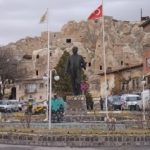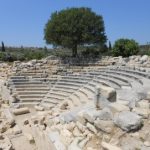The Ionians were Greeks who seem to have migrated to the coast of Anatolia (Asia Minor) in the 12th century BC, displacing the Carians who were already settled there and founding a string of independent city-states. In the mid-7th century they won what is called the Melian War against the local Carians whose territory was then divided with the Ionians keeping the more northerly portion and the Carians forced south.
To celebrate their victory, the Ionians formed the Panionic League, first mentioned by Herodotus, the “Father of History” and himself a Carian who was born in what was then Halicarnassus and is now Bodrum.
According to Herodotus, the Panionic League initially consisted of 12 city-states: Miletus, Priene, Ephesus, Teos, Erythrae, Myus, Colophon, Lebedos, Clazomenae, Phocaea (Foça), Samos and Chios. Later Smyrna (modern İzmir) also joined the league, which continued minting its own coins well into Roman times.
As in mainland Greece, the city-states of Ionia functioned independently, treating their union for the most part as a defense against the Persian threat. They did come together regularly, however, to celebrate the Panionia, a mini-Olympic Games combined with religious celebrations at the Panionium, a temple to the sea god Poseidon whose cult they had adopted from the Carians. Its location remained a mystery until 2004 when excavations on Samsun (Dilek) Dagı, also known as Mt. Mycale, above Priene, uncovered the remains of a temple dating back to the 6th century BC that appeared to fit the bill.
The Ionian cities were some of the most powerful and brilliant of their day. The great poet Homer is believed to have been an Ionian who was born in 8th-century Smyrna (or possibly Colophon), while the philosophers Thales (c.624- c.546 BC), Anaximander (c.610-c.546 BC), and Anaximenes (c.585-c.528 BC) were all born in Miletus, Heraclitus (c.535-c.475 BC) in Ephesus, and Bias (6th century BC) in Priene. The Ionic capital was first developed in Ionia in the 6th century BC, while it was the Ionic alphabet that formed the basis for the final Greek version. Interestingly, Yunan, the Turkish word for Greek, seems to have evolved from the word for an Ionian.
Modern visitors to the Aegean can visit the sites of many of the old Ionian cities from Phocaea (Foça), north of İzmir, to Miletus, south of Kuşadası. When visiting them, however, it’s important to remember that the ruins you see mainly postdate the Panionic period. Some of these cities were continuously occupied over many centuries and their monuments were rebuilt over and again, especially in the heyday of the Roman Empire. Rather unexpectedly the site with the largest number of remains surviving from Ionian times is Smyrna at Tepekule in İzmir.
Read more: http://www.todayszaman.com/news-305897-in-search-of-ancient-ionia-the-coast-around-izmir.html

